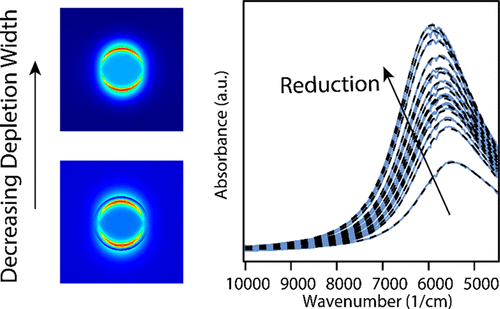当前位置:
X-MOL 学术
›
ACS Photonics
›
论文详情
Our official English website, www.x-mol.net, welcomes your feedback! (Note: you will need to create a separate account there.)
Rationalizing the Impact of Surface Depletion on Electrochemical Modulation of Plasmon Resonance Absorption in Metal Oxide Nanocrystals
ACS Photonics ( IF 7 ) Pub Date : 2018-03-21 00:00:00 , DOI: 10.1021/acsphotonics.7b01587 Ankit Agrawal 1 , Ilka Kriegel 2, 3 , Evan L. Runnerstrom 1, 3, 4 , Francesco Scotognella 5 , Anna Llordes 3 , Delia J. Milliron 1, 3
ACS Photonics ( IF 7 ) Pub Date : 2018-03-21 00:00:00 , DOI: 10.1021/acsphotonics.7b01587 Ankit Agrawal 1 , Ilka Kriegel 2, 3 , Evan L. Runnerstrom 1, 3, 4 , Francesco Scotognella 5 , Anna Llordes 3 , Delia J. Milliron 1, 3
Affiliation

|
Dynamic control over the localized surface plasmon resonance (LSPR) makes doped metal oxide nanocrystals (NCs) promising for several optoelectronic applications including electrochromic smart windows and redox sensing. Metal oxide NCs such as tin-doped indium oxide display tunable infrared LSPRs via electrochemical charge injection and extraction as a function of the externally applied potential. In this work we have employed dispersion phase electrochemical charging/discharging to study the mechanism behind the optical modulation on an individual NC scale. The optical modulation of the LSPR is dominated by a sharp variation in intensity during reduction and oxidation along with an only modest shift in the LSPR frequency. With a core–shell modeling approach, in which an active NC core surrounded by a depleted shell is assumed, we were able to reproduce the trends in and main features of our experimental results. The shell thickness depends on the applied potential and we extracted the temporal evolution of the shell thickness together with the variation of the Drude parameters until equilibrium was reached. The variation of the core versus shell volume fraction as a function of electrochemical potential reinforces the importance of the depletion layer in highly doped NCs and uncovers important implications on their near and far field plasmonic properties.
中文翻译:

合理化表面耗竭对金属氧化物纳米晶体中等离子体共振吸收的电化学调制的影响。
对局部表面等离子体激元共振(LSPR)的动态控制使掺杂的金属氧化物纳米晶体(NCs)有望用于包括光电致变智能窗和氧化还原传感在内的多种光电应用。诸如锡掺杂的氧化铟之类的金属氧化物NC根据外部施加的电势,通过电化学电荷注入和提取显示出可调谐的红外LSPR。在这项工作中,我们采用了分散相电化学充电/放电来研究单个NC规模上的光调制背后的机理。LSPR的光学调制方式主要是还原和氧化过程中强度的急剧变化,以及LSPR频率仅有适度的偏移。使用核-壳模型方法,其中假设一个活动的NC核被耗尽的壳包围,我们能够重现实验结果的趋势和主要特征。壳的厚度取决于所施加的电势,我们提取了壳厚度的时间演变以及Drude参数的变化,直到达到平衡为止。核与壳的体积分数随电化学势的变化,增强了高掺杂NC中耗尽层的重要性,并揭示了其近场和远场等离子体性能的重要意义。
更新日期:2018-03-21
中文翻译:

合理化表面耗竭对金属氧化物纳米晶体中等离子体共振吸收的电化学调制的影响。
对局部表面等离子体激元共振(LSPR)的动态控制使掺杂的金属氧化物纳米晶体(NCs)有望用于包括光电致变智能窗和氧化还原传感在内的多种光电应用。诸如锡掺杂的氧化铟之类的金属氧化物NC根据外部施加的电势,通过电化学电荷注入和提取显示出可调谐的红外LSPR。在这项工作中,我们采用了分散相电化学充电/放电来研究单个NC规模上的光调制背后的机理。LSPR的光学调制方式主要是还原和氧化过程中强度的急剧变化,以及LSPR频率仅有适度的偏移。使用核-壳模型方法,其中假设一个活动的NC核被耗尽的壳包围,我们能够重现实验结果的趋势和主要特征。壳的厚度取决于所施加的电势,我们提取了壳厚度的时间演变以及Drude参数的变化,直到达到平衡为止。核与壳的体积分数随电化学势的变化,增强了高掺杂NC中耗尽层的重要性,并揭示了其近场和远场等离子体性能的重要意义。



























 京公网安备 11010802027423号
京公网安备 11010802027423号